How to Get Rid of White Mold on Plants (Ultimate Guide)

White mold on plants looks like a fuzzy substance that is the result of fungus spores. The spores quickly grow on the plant leaves and stems to form a white fuzz that’s also called powdery mildew. This white fuzzy mold can affect indoor and outdoor plants, especially when growing conditions are warm, damp, and humid. Although white mold won’t kill a healthy plant, it can affect the plant’s growth. The airborne spores can easily infest nearby plants or create a furry white mold on plant soil.
How to Get Rid of White Mold on Plants
To kill mold on indoor plants, you can use a mixture of baking soda, water, and dish soap. Another natural method to get rid of houseplant mold is to make a milk spray, which helps to neutralize the cottony white mold. Neem oil is another natural mold remedy for indoor plants.
What is White Mold on Plants?
Powdery mildew or white fuzzy mold on plants is commonly caused by the fungal pathogen Podosphaera xanthii. The fungal disease creates a powdery white growth on plant leaves and stems. At the start, the white mold looks like powdery spots. However, as the fungal growth spreads, the white stuff can cover the entire plant.
Plants That Are Most Susceptible to White Mold
White fungal infections can affect most plants; however, there are some types of trees, shrubs, and flowers that are more susceptible to powdery mildew. Fungi from the order Erysiphales thrive in warm, humid conditions. So, very often, plants growing in temperate climates that have warm, humid summers are prone to white powder mold.
Indoor houseplants that are especially susceptible to mold include African violets, kalanchoe, begonias, indoor ivies, jade plants, and poinsettia.
Outdoor plants that are prone to white fungus infections include hydrangea, lilac, apple trees, oak trees, zinnia, roses, and strawberries.
Why Does White Mold Appear on Plants?
White fuzzy mold on plants develops when naturally-occurring fungal spores germinate and grow. The white fungal growth—also called mycelium—appears in warm, damp conditions, especially plants that grow in poor light. Overwatering houseplants and keeping them in the shade can cause white mold to appear.
Is White Fuzzy Mold Dangerous for Plants?
You generally don’t have to worry if you notice a powdery film on plant leaves. According to the Royal Horticultural Society, white fungus on plants isn’t dangerous. With some plants, this white leaf fuzz is unavoidable. Of course, white mold on soil or leaves is unattractive, so you probably want to know how to get rid of it quickly. (1)
How to Get Rid of Mold on Plants
Even though white fungal infections on plants are harmless, getting rid of the white fluff is fairly easy. You probably have most of the ingredients in your cupboards to make a natural fungicide spray at home.
For example, common baking soda is excellent at removing the white fuzzy deposits from leaves. You can also make an anti-mold spray by diluting regular milk with water and spraying it on the leaves. Even just improving your watering techniques can be enough to get rid of white mold spots on plants.
How to Use Baking Soda to Get Rid of White Mold on Plants
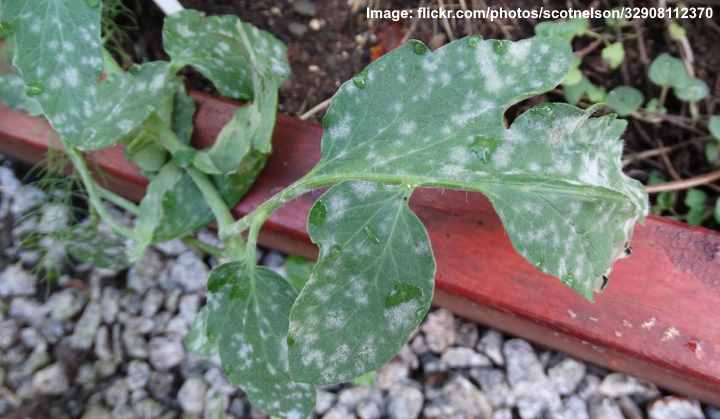
In the picture: white powdery mildew on tomato plant
Baking soda is one of the most common home remedies used to eliminate plant mold. For the anti-mold spray to be effective, you should mix the sodium bicarbonate with some dish soap, such as Dawn, and water. However, you may find that the baking soda mixture is better to prevent white plant mold than cure it.
How to make a baking soda spray to kill plant mold:
- Dissolve one tablespoon baking soda in 1/2 gallon (2 l) of water.
- To the mixture, add 1/2 teaspoon of liquid soap and mix thoroughly.
- Fill a spray bottle and liberally spray the white mold of the affected plant leaves and stems.
- Let the plant dry.
- Repeat as necessary until the white powdery mildew has gone.
If the baking soda solution seems ineffective, then you can try using potassium bicarbonate as a more powerful antifungal spray.
The addition of dish soap helps the baking soda stick to the plant and increase its effectiveness.
When using baking soda to get rid of white plant mold, it’s important to remember that the sodium content will eventually seep into the soil. In time, this can affect the plant’s growth. So, you may have to flush the soil occasionally to remove a buildup of salts and other minerals.
Use baking soda as a mold prevention treatment
The best way to use the baking soda spray for white mold problems is as a preventative treatment. Some houseplants are more susceptible to white fuzz than others. So, if you know you may have problems, use the spray early in the season.
To use the baking soda mold treatment recipe above, spray your plants every 2 weeks when indoor conditions are warm and humid.
Here are some top care tips when using baking soda sprays on plant fungus:
- Thoroughly water the potting soil two days before applying the baking soda mold spray.
- Don’t put the plant in the sun when the anti-mold spray is drying.
- Always make a fresh batch of baking soda spray before using it.
Neem Oil Homemade Spray to Kill Powdery Mildew and Mold on Plants
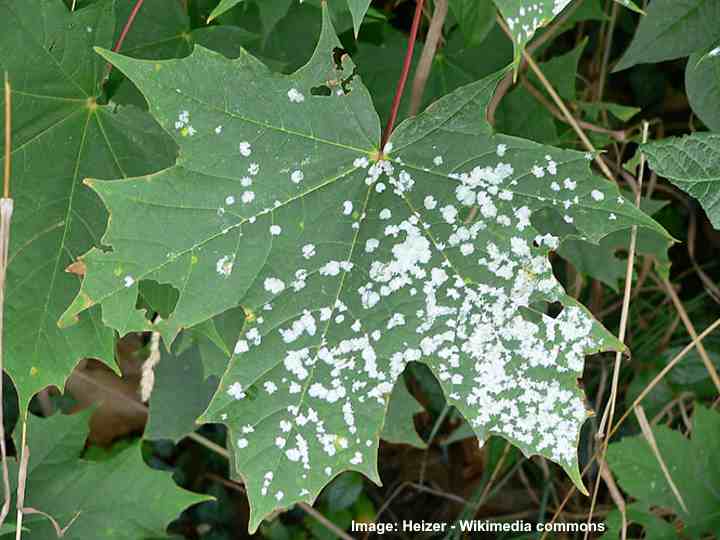
This image shows powdery mildew spots on acer leaf
You can try using neem oil in another type of spray to attack powdery mildew on plant leaves. Neem oil is a well-known natural insecticide, and it could be effective in wiping powdery white mold from leaves. The neem oil antifungal spray will help resolve your mold problems and, at the same time, kill off common houseplant pests.
Many studies show that neem oil has fungicidal activities. For example, in a spray solution, neem oil was effective in eliminating powdery mildew from ornamental plants. The organic insecticidal and fungicidal solution didn’t harm the plants. Neem oil was also effective against plant rust—another fungal disease that affects plants. (2)
How to make a neem oil spray to kill white mold on indoor plants
- Mix two teaspoons of organic neem oil with 1/2 a gallon (2 l) of water.
- To emulsify the solution, thoroughly mix in one teaspoon of dish soap.
- Pour the neem oil solution in a spray bottle and liberally spray the white mold on plant leaves and stems.
You can also use this neem oil recipe as an antifungal soil flush. This is especially effective if you have a fuzzy white mold on plant roots. You can also flush the soil if you need to get rid of fungus gnats naturally.
Milk Spray for Powdery Mildew and White Mold on Plants
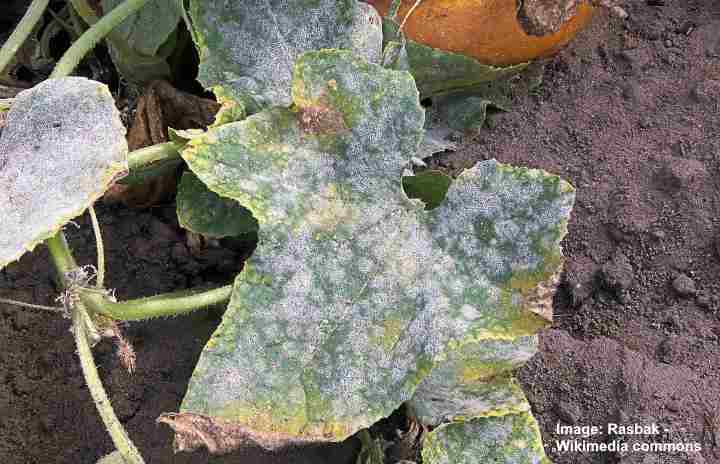
White fungus on cucumber leaves
A natural milk spray can help eliminate powdery white coatings on plant leaves and stems. This type of anti-mold spray for plants is safer than spraying toxic chemicals on the leaves.
No one is quite sure why milk sprays work on white plant mold. However, it is thought that some chemicals in cow’s milk have fungicidal activities on plants. Some studies indicate that lactic acid bacteria found in milk have an antifungal effect. However, no studies have been carried out on using milk as a fungicide on plants. (2)
How to get rid of white mold on houseplants using milk
- Make a solution using a 40/60 ratio of milk to water.
- Fill a spray bottle with the milk solution.
- Spray on the white fuzzy mold of the affected plant leaves and stems.
- Place the treated plant in direct sunlight to dry.
- Repeat the antifungal treatment on your plants every 10 to 14 days to get rid of the mold.
The advice to put the treated plant in direct sunlight is thought to make the mold spray more effective.
Use milk spray to help prevent white plant mold
Similar to the baking soda remedy, milk is most effective on plants to prevent white fuzz on leaves and stems. You should start spraying your susceptible plants every two weeks when the weather becomes warmer. Using milk spray this way may prevent powdery mildew from appearing on your plants.
The advantages of milk spray over sodium bicarbonate sprays is that it doesn’t affect the mineral balance in the potting mix. The only disadvantage is the unpleasant sour smell. But that should disappear fairly quickly.
Apple Cider Vinegar (ACV) to Treat White Plant Mold

White mildew on the leaf of the English oak
Apple cider vinegar is another household item that has antifungal properties. Using a mixture of ACV and water may be enough to get rid of white fuzz from plant leaves. All you need is to make a diluted solution to help tackle your plant mold problem.
Many studies have been carried out into the effectiveness of vinegar as an antifungal agent. The main compound in vinegar is acetic acid. Although no studies have been carried out on its effectiveness on plant mold, you can try this method to remove white cottony growth on plants.
How to make a vinegar spray to get rid of mold on plants
- Mix one to one and a half tablespoons of apple cider vinegar with 1/2 a gallon (2 l) of water.
- Pour the ACV mixture into a spray bottle.
- Spray all parts of the plant affected by the powdery mildew or white fuzzy mold.
- Spray your plants every two weeks to help get rid of plant mold for good.
With the vinegar recipe, you can also substitute ACV for regular white vinegar. However, it’s important to remember that vinegar is acidic. So, don’t use a stronger concentration, or you could burn the leaves. It’s recommended to test one leaf, first of all, to see how the leaves react.
How to Prevent and Treat White Mold on Plants
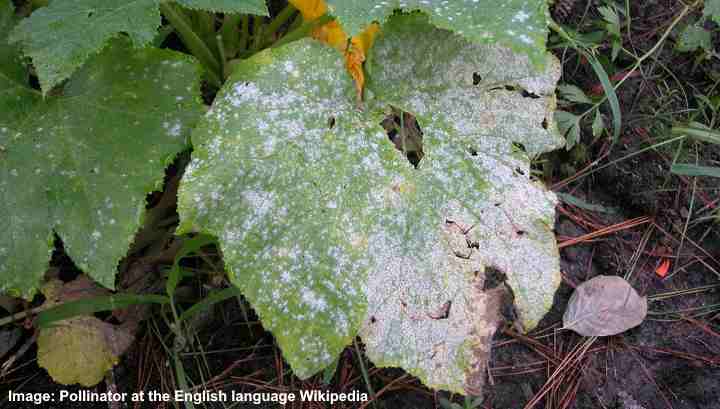
Powdery mildew on plant leaves
It is much easier to prevent white stringy mold appearing on plants and soil than treating the disease. Although white fuzz won’t kill houseplants, the mold causes unsightly white blotches on plants. If left untreated, all the leaves could look white and furry. The fungal disease will also affect other houseplants.
To know how to prevent white mold on houseplants, you need to know how the spores grow and multiply. Four factors combine to make conditions ideal for fungal infections. These are:
- Warm temperatures between 60°F and 80°F (15°C – 26°C).
- Humid air.
- Inadequate sunlight.
- Poor air circulation.
Of course, it may not be possible to change all of those conditions. For example, many tropical plants need high humidity levels to thrive. Also, you may grow low-light plants at home because you have north-facing windows. So, what can you do to prevent white mold on plant leaves and stems? Here are a few ideas:
Choose the right location—Grow plants susceptible to white mold in locations where they get early morning sun. This helps any moisture accumulated during the night to evaporate quickly.
Improve air circulation—Don’t grow houseplants together if you’ve got problems with white fuzzy mold. Putting several plants near each other increases moisture and restricts airflow.
Check plants regularly—Check plants every few days to spot signs of white mold on leaves. If you notice any diseased leaves, pinch them off and destroy them. You should also check for soil dryness.
Water plants appropriately—White plant fungal diseases thrive on dampness. So, it’s essential to know how to water plants properly. Before watering houseplants, press the soil firmly to see if there’s any moisture. If so, don’t water your plant. Wait until the top part of the soil is dry before giving your plants a deep watering.
Preventative mold control—If your plants are susceptible to mold, use a baking soda, neem oil, or milk spray to help prevent mold from growing. Spray your plants every two weeks during warm weather to suppress fungal spore growth.
How to Treat White Fuzzy Mold on Houseplant Potting Soil
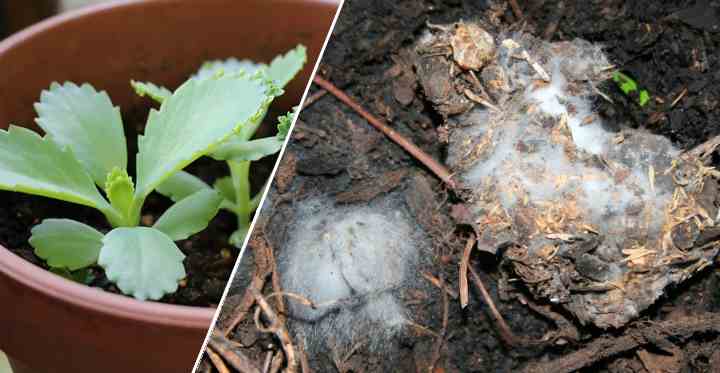
If your indoor plants get powdery white mold on the leaves, it’s highly likely that you’ll get white fungus on the soil. What should you do if you notice a cotton-like growth on plant pot soil?
Similar to white fluff on leaves, this white stuff on the soil isn’t dangerous to your plant. In many cases, you can just scrape the white fuzz off the soil and replace the top 2” of potting soil.
If the fungal disease is extensive and has affected the roots, your best solution is to repot your plant. You should safely dispose of the diseased soil and replace it with a fresh sterile potting mix.
Related articles:
- How to Get Rid of Mold on Houseplant Soil
- How to Water Indoor Plants Correctly
- How to Get Rid of Pests in Houseplants
